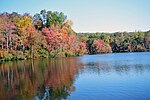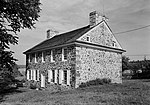North Warwick Historic and Archeological District
Archaeological sites on the National Register of Historic Places in PennsylvaniaGeorgian architecture in PennsylvaniaHistoric districts in Chester County, PennsylvaniaHistoric districts on the National Register of Historic Places in PennsylvaniaNRHP infobox with nocat ... and 2 more
National Register of Historic Places in Chester County, PennsylvaniaUse mdy dates from August 2023

The North Warwick Historic and Archeological District is a national historic district that is located in Warwick Township, Chester County, Pennsylvania. It was added to the National Register of Historic Places in 1995.
Excerpt from the Wikipedia article North Warwick Historic and Archeological District (License: CC BY-SA 3.0, Authors, Images).North Warwick Historic and Archeological District
Harmonyville Road, Warwick Township
Geographical coordinates (GPS) Address Nearby Places Show on map
Geographical coordinates (GPS)
| Latitude | Longitude |
|---|---|
| N 40.188333333333 ° | E -75.768888888889 ° |
Address
Harmonyville Road 2632
19520 Warwick Township
Pennsylvania, United States
Open on Google Maps








